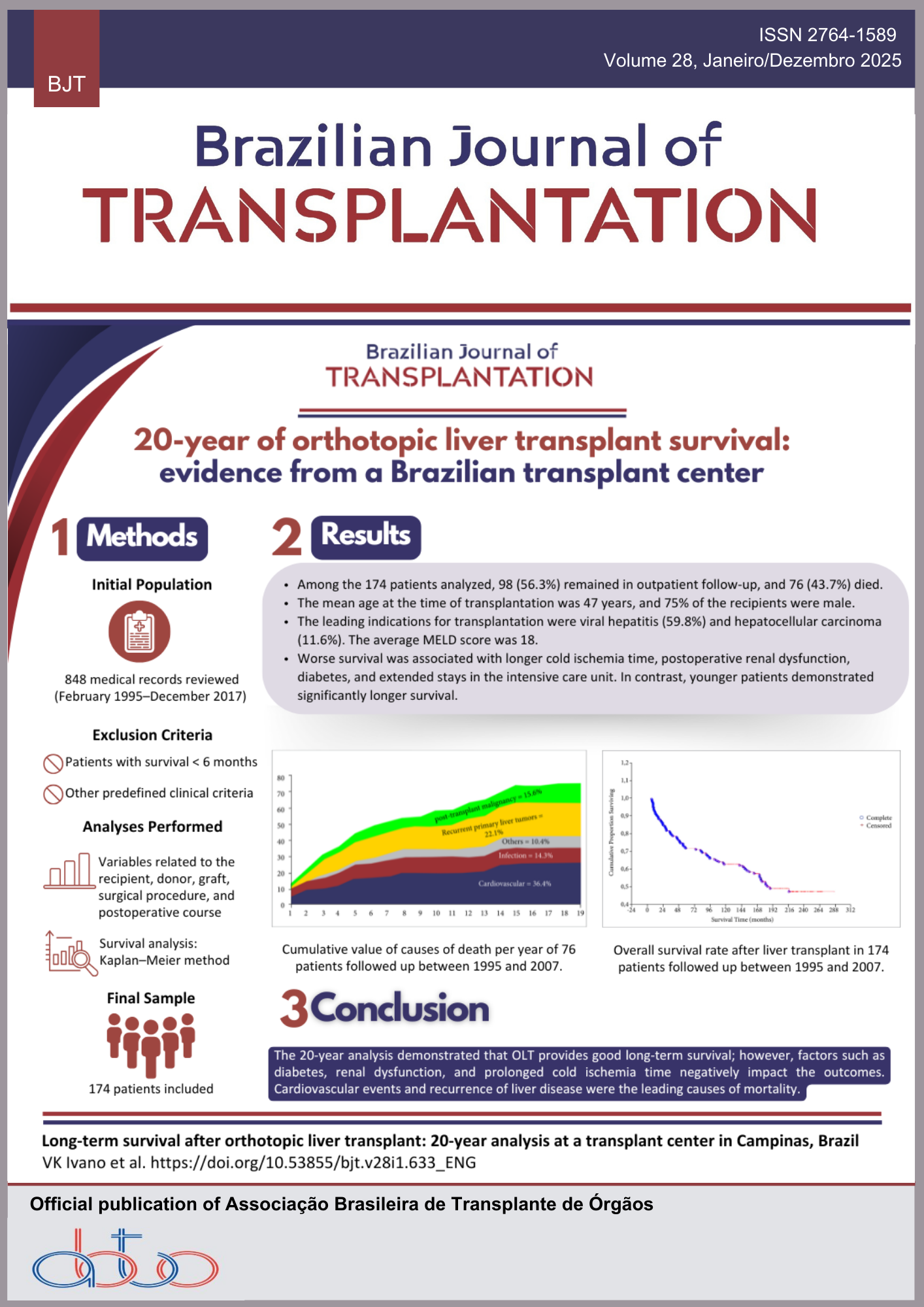Sobrevivência a Longo Prazo após Transplante Ortotópico de Fígado: Análise de 20 anos em um Centro de Transplante em Campinas, Brasil
Palavras-chave:
Transplante de Fígado, Sobrevida, Insuficiência Hepática, Doença Hepática Crônica, Mortalidade Hospitalar, Fatores PrognósticosResumo
Introdução: O transplante ortotópico de fígado (TOF) é a principal terapia para doença hepática terminal. No Brasil, a realização de transplantes aumentou significativamente nas últimas décadas, com melhorias nos desfechos a longo prazo. Este estudo analisa a sobrevida de pacientes submetidos a TOF ao longo de 20 anos em um centro de referência. Métodos: Foram revisados os prontuários de 848 pacientes transplantados entre fevereiro de 1995 e dezembro de 2017. Aplicaram-se critérios de exclusão, incluindo pacientes com sobrevida inferior a 6 meses, visando minimizar o impacto de complicações precoces no desfecho de longo prazo. Dessa forma, 174 pacientes foram incluídos. As variáveis analisadas envolveram dados do receptor, doador, enxerto, procedimento cirúrgico e evolução pós-operatória. A sobrevida foi avaliada por Kaplan–Meier. Resultados: Dos 174 pacientes analisados, 98 (56,3%) mantiveram seguimento ambulatorial e 76 (43,7%) evoluíram a óbito. A média de idade no transplante foi de 47 anos, e 75% dos receptores eram do sexo masculino. As principais indicações foram hepatite viral (59,8%) e carcinoma hepatocelular (11,6%). A média do escore MELD foi 18. A principal causa de morte foi evento cardiovascular (36,4%), seguido de recidiva da doença hepática (22,1%) e neoplasias (15,6%). O tempo médio de sobrevida foi de 223 meses entre os pacientes vivos e 112 meses entre os óbitos (p < 0,0001). Maior tempo de isquemia fria, insuficiência renal pós-operatória, diabetes e maior tempo de internação em UTI foram fatores associados a pior sobrevida. Pacientes mais jovens apresentaram sobrevida significativamente superior (p = 0,00007). Conclusão: A análise de 20 anos mostrou que o TOF apresenta boa sobrevida a longo prazo, mas fatores como diabetes, disfunção renal e tempo prolongado de isquemia fria impactam negativamente os desfechos. Eventos cardiovasculares e recidiva da doença hepática foram as principais causas de mortalidade.
Downloads
Referências
1. Olthoff K, Kulik L, Samstein B, Kaminski M, Abecassis M, Emond, J, et al. Validation of a current definition of early allograft dysfunction in liver transplant recipients and analysis of risk factors. Liver Transpl 2010; 16(8): 943-9. https://doi.org/10.1002/lt.22091
2. Siqueira LR, Siqueira LR, Mendes KDS, Galvão CM. Epidemiological profile and complications of patients waiting for liver transplantation. Braz J Transplant 2023 ;26: e1923. https://doi.org/10.53855/bjt.v26i1.508_ENG
3. van der Meulen T, Mawla AM, DiGruccio MR, Adams MW, Nies V, Dólleman S, et al. Virgin beta cells persist throughout life at a neogenic niche within pancreatic islets. Cell Metab 2017; 25(4): 911-26. e6. https://doi.org/10.1016/j.cmet.2017.03.017
4. Wong RJ, Singal AK. Trends in liver disease etiology among adults awaiting liver transplantation in the United States, 2014-2019. JAMA Netw Open 2020; 3(2): e1920294. https://doi.org/10.1001/jamanetworkopen.2019.20294
5. Lima AS, Pereira BB, Jungmann S, Machado CJ, Isabel MITD. Fatores de risco para complicações biliares pós-transplante hepático na ausência de complicações arteriais. Arq Bras Cir Dig 2020; 33(3): e1541. https://doi.org/10.1590/0102-672020200003e1541
6. Gulla A, Jakiunaite I, Juchneviciute I, Dzemyda G. A narrative review: Predicting liver transplant graft survival using artificial intelligence modeling. Front Transplant 2024; 3: 1378378. https://doi.org/10.3389/frtra.2024.1378378
7. Nitski O, Azhie A, Qazi-Arisar FA, Wang X, Ma S, Lilly L, et al. Long-term mortality risk stratification of liver transplant recipients: real-time application of deep learning algorithms on longitudinal data. Lancet Digit Heal 2021; 3(5): e295-305. https://doi.org/10.1016/S2589-7500(21)00040-6
8. Silveira F, Silveira FP, Freitas ACT, Coelho JCU, Ramos EJB, Macri MM, et al. Liver transplantation: Survival and indexes of donor-recipient matching. Rev Assoc Med Bras 2021; 67(5): 690-5. https://doi.org/10.1590/1806-9282.20201088
9. Kaido T. Recent evolution of living donor liver transplantation at Kyoto University: How to achieve a one-year overall survival rate of 99%? Hepatobiliary Pancreat Dis Int 2020; 19(4) :328-33. https://doi.org/10.1016/j.hbpd.2020.06.006
10. Di Maira T, Little EC, Berenguer M. Immunosuppression in liver transplant. Best Pract Res Clin Gastroenterol 2020; 46-7: 101681. https://doi.org/10.1016/j.bpg.2020.101681
11. Wallace D, Walker K, Charman S, Suddle A, Gimson A, Rowe I, et al. Assessing the impact of suboptimal donor characteristics on mortality after liver transplantation: A time-dependent analysis comparing HCC with non-HCC patients. Transplantation 2019; 103(4): e89-98. https://doi.org/10.1097/TP.0000000000002559
12. Rodríguez-Perálvarez M, Tsochatzis E, Naveas MC, Pieri G, García-Caparrós C, O’Beirne J, et al. Reduced exposure to calcineurin inhibitors early after liver transplantation prevents recurrence of hepatocellular carcinoma. J Hepatol 2013; 59(6): 1193-9. https://doi.org/10.1016/j.jhep.2013.07.012
13. Carenco C, Assenat E, Faure S, Duny Y, Danan G, Bismuth M, et al. Tacrolimus and the risk of solid cancers after liver transplant: A dose effect relationship. Am J Transplant 2015; 15(3): 678-86. https://doi.org/10.1111/ajt.13018
14. Schoening WN, Buescher N, Rademacher S, Andreou A, Kuehn S, Neuhaus R, et al. Twenty-year longitudinal follow-up after orthotopic liver transplantation: a single center experience of 313 consecutive cases. Am J Transplant 2013;13(9): 2384-94. https://doi.org/10.1111/ajt.12384
15. Åberg F, Gissler M, Karlsen TH, Ericzon BG, Foss A, Rasmussen A, et al. Differences in long-term survival among liver transplant recipients and the general population: a population-based Nordic study. Hepatology 2015; 61(2): 668-77. https://doi.org/10.1002/hep.27538
16. Watt KDS, Pedersen RA, Kremers WK, Heimbach JK, Charlton MR. Evolution of causes and risk factors for mortality post-liver transplant: results of the NIDDK long-term follow-up study. Am J Transplant 2010; 10(6): 1420-7. https://doi.org/10.1111/j.1600-6143.2010.03126.x
17. Bhat M, Mara K, DIerkhising R, Watt KD. Gender, Race and disease etiology predict de novo malignancy risk after liver transplantation: insights for future individualized cancer screening guidance. Transplantation 2019; 103(1): 91-100. https://doi.org/10.1097/tp.0000000000002113
18. Bhat M, Ghali P, Rollet-Kurhajec KC, Bhat A, Wong P, Deschenes M, et al. Serum fibrosis biomarkers predict death and graft loss in liver transplantation recipients. Liver Transpl 2015; 21(11): 1383-94. https://doi.org/10.1002/lt.24217
19. Feng S, Goodrich NP, Bragg-Gresham JL, Dykstra DM, Punch JD, DebRoy MA, et al. Characteristics associated with liver graft failure: the concept of a donor risk index. Am J Transplant 2006; 6(4): 783-90. https://doi.org/10.1111/j.1600-6143.2006.01242.x
20. Sastre L, García R, Gándara J-G, Ruiz P, Lombardo J, Colmenero J, et al. Incidence, predictors, and impact on survival of long-term cardiovascular events after liver transplantation. Transplantation 2020; 104(2): 317-25. https://doi.org/10.1097/tp.0000000000002852
21. Bhat V, Tazari M, Watt KD, Bhat M. New-onset diabetes and preexisting diabetes are associated with comparable reduction in long-term survival after liver transplant: a machine learning approach. Mayo Clin Proc 2018; 93(12): 1794-802. https://doi.org/10.1016/j.mayocp.2018.06.020
22. Gil E, Kim JM, Jeon K, Park H, Kang D, Cho J, et al. Recipient age and mortality after liver transplantation: a populationbased cohort study. Transplantation 2018; 102(12): 2025-32. https://doi.org/10.1097/tp.0000000000002246
23. Minich A, Arisar FAQ, Shaikh N ul S, Herman L, Azhie A, Orchanian-Cheff A, et al. Predictors of patient survival following liver transplant in non-alcoholic steatohepatitis: A systematic review and meta-analysis. eClinicalMedicine 2022; 50: 101534. https://doi.org/10.1016/j.eclinm.2022.101534
Downloads
Publicado
Como Citar
Edição
Seção
Licença
Copyright (c) 2025 Victor Kenzo Ivano, Rafaela Hamada Jucá, Arthur Nunes Martins Neto, Fernanda Kreve, Tiago Diniz, Alexandre Foratto, Derli Conceição Munhoz, Eduardo Riccetto, Caique Fernandes Alves, Simone Reges Perales, Elaine Cristina Ataide, Ilka de Fátima Santana F. Boin

Este trabalho está licenciado sob uma licença Creative Commons Attribution 4.0 International License.

















